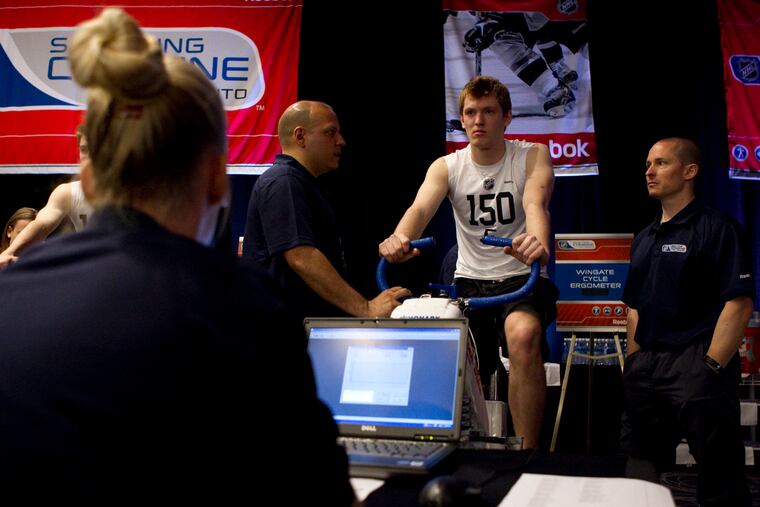NHL draft combine: Previewing each test the top prospects will be put through this week
After years of honing their hockey skills, the top prospects in the class of 2022 will be put through a battery of tests at the NHL draft combine in Buffalo, N.Y.

After years of working on improving their skating, hands, and other on-ice skills, the top hockey prospects in the class of 2022 will step off the ice and demonstrate their athleticism in T-shirts and gym shorts this week at the 2022 NHL draft combine in Buffalo, N.Y.
With scouts, general managers, and other team personnel watching, the best players eligible for the 2022 NHL draft will go through a series of medical, physical, and psychological tests. The prospects — 86 are expected to attend — arrived Sunday in Buffalo to start meeting with teams. On Thursday, they will go through medical examinations and basic physicals. Friday features what many players consider the most difficult tests, including the Wingate test on the exercise bike, while the remaining assessments will be completed Saturday. The draft is July 7-8 in Montréal.
» READ MORE: John Tortorella? Barry Trotz? Does it matter whom the Flyers hire as their next coach?
Here’s a look at everything the prospects will be tested on and asked to do this week at the combine:
Interviews
One of the most stressful and mentally taxing elements of the combine, the interview process entails players going from team to team, meeting members of front offices in a speed dating-esque format. They talk to an assortment of amateur scouts, assistant general managers, and, occasionally, general managers, among other front office personnel. Usually the conversation is about on-ice performance and character, but the talks can veer in seemingly random directions as teams try to get a feel for a prospect’s mental makeup and how he would react in a given scenario.
Measurements
The players’ wingspans and heights are measured to the closest quarter-inch with a portable height measuring device used to determine each player’s height without footwear. The wingspan is measured from middle fingertip to middle fingertip.
Y balance
The athlete must stand on one leg and extend the other in three directions as instructed. Each test is performed three times, and the maximum reach is recorded. The exercise tests strength, flexibility, and core control. It also is used to identify athletes at greater risk for lower extremity injury.
Functional movement screen
These basic movement tests are designed to uncover underlying weaknesses and right-left imbalances as well as reveal quality of movement. Using a scale of 0-3, assessors score mobility and stability in seven tests — deep squat, hurdle step, in-line lunge, shoulder mobility, active straight leg raise, trunk stability push-up, and rotary stability.
Bench press
Players bench 50% of their own body weight, and the power of their lifts is measured. They must perform three reps at maximum velocity.
Pull-ups
Players do as many pull-ups as they can while maintaining proper form. This test was added in 2014 and measures forearm strength, upper-arm strength, and endurance. Several players have been drafted highly despite failing to do a single pull-up. Montreal Canadiens forward Cole Caufield was one of four players to do 16 pull-ups at the last combine in 2019.
» READ MORE: 2022 NHL draft: Scouting the North American forwards the Flyers could target at pick No. 5
Wingate test
In one of the most feared tests of the combine, players get on a spin bike and warm up with a low resistance for two minutes. Then the athlete pedals at a progressively quicker speed so that by the time the designated workload has been reached, he is pedaling at max capacity. The athlete pedals at his max capacity against the designated workload for 30 seconds. The athlete must remain firmly seated on the bike during the duration of the test. Revolutions are recorded for each five-second period, then power output is calculated for the peak five-second period and the 30-second duration. This exercise is one way to measure an athlete’s power and fatigue index.
VO2 max test
Like the Wingate test, players ride a spin bike. As they ride, the resistance increases. The players continue to ride until they cannot keep up the required revolutions per minute. They are allowed to stand up as they pedal. Before starting, the athletes are hooked up to a heart rate monitor and put on a mask that monitors how much oxygen they use, or their VO2 output. The VO2 test is used to determine an athlete’s capacity to perform a sustained exercise and calculate aerobic endurance and cardiovascular fitness.
Grip strength
This is measured with a hand grip dynamometer, which is adjusted to fit the player’s hand size. The player then extends his arm and grips it as tightly as possible. Assessors do a reading for each hand.
Standing long jump
Starting from a standstill, players jump as far as they can. They may use their arms for momentum. The distance is measured from the starting point to closest heel mark. A player has three tries, and the best attempt is recorded. In 2015, Brendan Guhle, who was drafted by the Buffalo Sabres, jumped 122 inches.
Jump station
Players perform three types of straight up-and-down jumps. They do a jump with an arm swing, one with no arm swing, and one from a squat position. They have three tries for each.
An AccuPower Dual Force Plate system measures the direction, strength, and timing of the forces the player produces. High-speed camera technology also helps scouts evaluate movement efficiency, physical performance, and injury potential.
5-10-5 yard shuttle
This timed test measures multidirectional speed, agility, whole body reaction, and control. The athlete runs 5 yards to the right, 10 yards to the left and then 5 yards to the right. Times are recorded with a laser timer.
» READ MORE: 2022 NHL draft: Scouting the defensemen the Flyers could target with pick No. 5